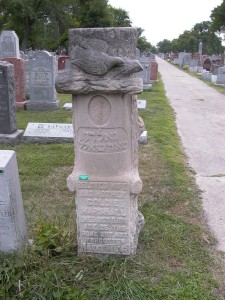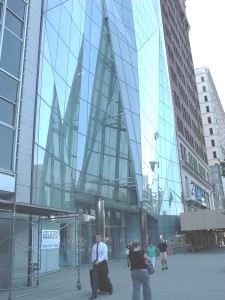Chicago in Pictures
Edited Monday night, due to moral obligation. Before I left California, I stated that one of the things I would be doing in Chicago was seriously beating (again!) my identical twin nephews in Pictionary, despite their great psychic bond. Son and I have done amazingly well against them in the past. Tonight, though, I am forced to confess, as publicly as I bragged before, that they whooped us well, fair and square. Congrats, guys. Until next time!
So the research trip is over. I had a great time in Chicago–parts of it look completely new and metallic-shiny, as if the sinking wooden streets and the women in long skirts never existed. Other parts have had asphalt and cement added around them, but the buildings are the same that people lived in 100 years ago, including my grandmother.

She’s sitting on her mother’s lap at her parents’ 25th anniversary party. We think she’s two or three. The roses her mother’s holding are right in her face, and she’s being asked to pose for the photographer which, even when I knew her, she never liked doing. She’s also the one who, many decades later, identified 35 out of 45 of the people at the party, giving my sister, my sister-in-law, and me the start of the many ancestry hunts we’ve been doing. Obsessively. If any of you know where to find Nuchka Krupnick in 1920, send me a line, will you?
This is the house my grandmother lived in.

The story is that she and her twin sister would sleep on the balcony when it was too hot inside. Some of the houses also had balconies in the back–we drove around to try and find out if “ours” had one of those, but both my sister and I are navigationally challenged, and, honestly, we had some problem figuring out which back went with which front. So I’m saying, here and now, that this is the balcony my grandmother slept on. 🙂
We actually did family stuff on the last morning in Chicago–finding this house and heading out to a Jewish cemetery in Forest Park. A HUGE Jewish cemetery that, way back when, was 300 LITTLE Jewish cemeteries. They are SO organized. Everyone’s in their computers; they can tell you lot number, section number, row number, and grave number. And whether your relative has a monument. Ours did.

This great-aunt died in 1918 in the influenza epidemic. She was about 25; my grandmother would have been seven.
Okay, yes, we did do non-family historical research, too.
Our first stop when we got to Chicago was at the Spertus Institute of Jewish Studies.

See what I mean by new and shiny?
I had called ahead, a couple of weeks ago, just to check in about stopping by, and the librarians already had books pulled for me, including an unpublished memoir by a man who grew up in Chicago during the time my book is set. The librarians also gave me several other titles to look for AND showed me how to get into the historic archives of the Chicago Tribune.
The next morning, we headed over to the place I’d been looking forward to most–the Hull-House museum.

First surprise? The photos I’ve seen of Hull-House are pretty dark–those black & white ones we all know so well. So I’ve had an image in my head of it as a dark, kind of foreboding place. That, you know, Jane Addam’s personality made bright & cheerful. (If you haven’t yet seen the early b-day present my sister bought me here, take a look.
Lovely, pinkish-red brick. You just don’t think about/imagine houses built of brick when you grow up in California. (Earthquakes + bricks = bad.) Hull-House doesn’t allow photos inside, or I’d be able to show you the tall, spacious rooms with light walls and lots of windows. The house was also smaller than I expected. (This is the original house, during the years Hull-House was open, it expanded to include an entire block of buildings–most of those are gone now.) Being a reader of British mysteries, and living now in the world of Silicon Valley McMansions, I was expecting country-house huge. Instead, when you walk in, you are in a main entry room, with stairs heading up to the 2nd floor, flanked by one other room on each side, and a small room in the back. In the building next door, which used to be attached, the dining room downstairs and the music room upstairs probably fit about 100 people. When Hull-House first opened, club meetings and dances were held in the two outer rooms in the main house–NOT big enough for the hundreds of club members and dancers I had been visualizing.
I’m not sure how all this will affect my story. I do know that I have a feeling of a cozier, more intimate settlement house than I did before, and I know that will make changes in the scenes I’ve written and the ones I’ve only imagined. In a good way, I think. Seeing my grandmother’s house and other up-and-down buildings with two or three apartments in them is making me reconsider who lives where and how far they all have to travel to get to each other. And what happened in their pasts, before they moved into these new places. I found out in Hull-House that tenements were not the big sky-scrapy buildings, with hundreds of apartments (and thousands of people) inside them, but smaller structures–originally built to house two or three families, eventually over-crowded by putting several families into each apartment space. The bigger buildings came later–maybe after WWI? Again, this shifts the images in my mind into something less modern, maybe more interconnected, but–in a way–just as cramped and crumbling and wrong.
One big question for me about this trip was and still is–is there some way in which all this family stuff weaves into my writing of this story. When I started with this idea, there were no connections for me–my MC wasn’t even Jewish. I come from a family with a long history of secular, cultural Judaism–not religious, which has–in some ways–been comfirmed by the trip and by the ancestry hunting my sister and I have been doing. I have no idea, yet, how/if any of that will play out in this book. Today, I say no. But, six months ago, I had no idea that I’d be driving through Chicago, hunting for the #871 on house addresses or walking through an old cemetery searching for the name Goldie. Most likely, the ties between Caro’s story and mine are going to stay inside me, somewhere in feelings and genetic memories, rather than in the words on the page. I suspect, though, that the common threads will pop up every now and then and surprise me and–hopefully–add a depth to this book that I will welcome with heartfelt thanks.
One “for instance”–what do you all think of Clara, instead of Caro? Just sayin’.


14 Comments
WOW. Seeing your grandmother’s house gives me chills. I’m so thrilled you had a great trip.
LikeLike
It was pretty amazing. One of those moments that you can only do so much, but you hate to leave–you may not come back, or the house may not be there years later…
LikeLike
The ways they pop up will be special little treats for you in your writing. And they will make a huge difference!
LikeLike
That’s the plan. And the hope! 🙂
LikeLike
That was a moving post, Becky. I think it’s wonderful that you’re weaving pieces of your own family’s story into the one that you’re writing. (I like the name Clara, too.)
LikeLike
It makes the story carry a lot of weight in my own life, I think. Hey, I was telling my sister about your book, and she wants Me to get it for Her for Christmas. Which I will do! 🙂
LikeLike
What a rich experience that sounds like! The library — with those books and helpful librarians waiting! The old homestead and cemetary. Hull House — which I imagined as taller, darker, more rambling as you did. Worth it just for that.
It will be exciting seeing changes happen. And I also like the name Clara.
Hope you’re catching up on rest (with Jane doll propped nearby — I believe they give those dolls to those who win the Jane Addams book award.)
LikeLike
Oh! I had no idea you could WIN the doll. Oh, well, I’ll just have to leave room for two. 🙂
They had some old photos of the house, IN the house–and you could see that it was the lighting & the photographic quality. The house itself was just beautiful. Yes, I could live there.
LikeLike
What a fascinating trip, Becky! I’m sure the information you gathered will help shape your writing and add texture to it. My husband’s grandfather also died of the flu (the swine flu) back in 1918.
If you’re looking for a well-researched children’s book on life in a tenement, albeit a NYC tenement, take a look at Deborah Hopkinson’s book, Shutting Out the Sky.
LikeLike
Thanks, Stella. I have been looking for some details–I’ll take a look at that book. You’re adding to my happy feeling about librarians today!
LikeLike
This sounds like it has been such a wonderfully rich experience for you. I’m so glad you’ve had this chance.
And HAPPY BIRTHDAY!!!
LikeLike
Thanks, Susan!
LikeLike
How wonderful! I like the idea that your history will intertwine with Caro/Clara. I think Clara sounds more traditional, Caro sounds more unusual. I guess it depends on which one your character needs to be for the time she was living in.
LikeLike
Sigh. She’s been Caro in my head so long, but I keep running up against problems with the names. We’ll see. 🙂
LikeLike